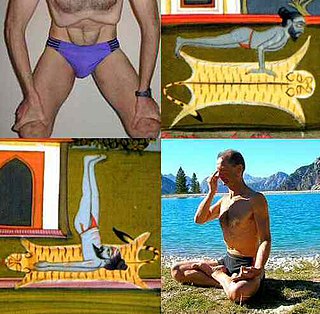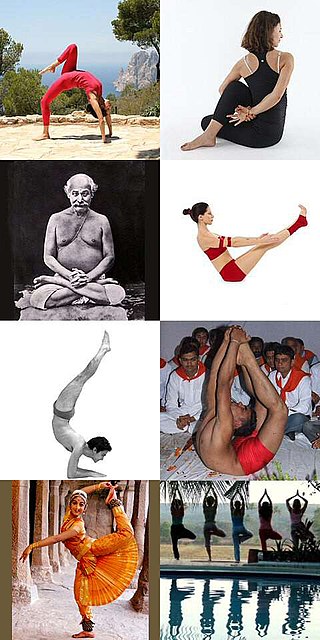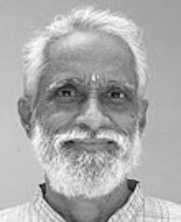Related Research Articles
In yoga, Indian medicine and Indian martial arts, prana permeates reality on all levels including inanimate objects. In Hindu literature, prāṇa is sometimes described as originating from the Sun and connecting the elements.

Hatha yoga is a branch of yoga which uses physical techniques to try to preserve and channel the vital force or energy. The Sanskrit word हठ haṭha literally means "force", alluding to a system of physical techniques. Some hatha yoga style techniques can be traced back at least to the 1st-century CE, in texts such as the Hindu Sanskrit epics and Buddhism's Pali canon. The oldest dated text so far found to describe hatha yoga, the 11th-century Amṛtasiddhi, comes from a tantric Buddhist milieu. The oldest texts to use the terminology of hatha are also Vajrayana Buddhist. Hindu hatha yoga texts appear from the 11th century onwards.

Bellur Krishnamachar Sundararaja Iyengar was an Indian teacher of yoga and author. He is founder of the style of yoga as exercise, known as "Iyengar Yoga", and was considered one of the foremost yoga gurus in the world. He was the author of many books on yoga practice and philosophy including Light on Yoga, Light on Pranayama, Light on the Yoga Sutras of Patanjali, and Light on Life. Iyengar was one of the earliest students of Tirumalai Krishnamacharya, who is often referred to as "the father of modern yoga". He has been credited with popularizing yoga, first in India and then around the world.

An āsana is a body posture, originally and still a general term for a sitting meditation pose, and later extended in hatha yoga and modern yoga as exercise, to any type of position, adding reclining, standing, inverted, twisting, and balancing poses. The Yoga Sutras of Patanjali define "asana" as "[a position that] is steady and comfortable". Patanjali mentions the ability to sit for extended periods as one of the eight limbs of his system. Asanas are also called yoga poses or yoga postures in English.

Prānāyāma is the yogic practice of focusing on breath. In Sanskrit, prana means "vital life force", and yama means to gain control. In yoga, breath is associated with prana, thus, pranayama is a means to elevate the pranashakti, or life energies. Pranayama is described in Hindu texts such as the Bhagavad Gita and the Yoga Sutras of Patanjali. Later in Hatha yoga texts, it meant the complete suspension of breathing.

Satyananda Saraswati, was a Sanyasi, yoga teacher and guru in both his native India and the West. He was a student of Sivananda Saraswati, the founder of the Divine Life Society, and founded the Bihar School of Yoga in 1964. He wrote over 80 books, including the popular 1969 manual Asana Pranayama Mudra Bandha.

Gheranda Samhita is a Sanskrit text of Yoga in Hinduism. It is one of the three classic texts of hatha yoga, and one of the most encyclopedic treatises in yoga. Fourteen manuscripts of the text are known, which were discovered in a region stretching from Bengal to Rajasthan. The first critical edition was published in 1933 by Adyar Library, and the second critical edition was published in 1978 by Digambarji and Ghote. Some of the Sanskrit manuscripts contain ungrammatical and incoherent verses, and some cite older Sanskrit texts.

The shatkarmas, also known as shatkriyas, are a set of Hatha yoga purifications of the body, to prepare for the main work of yoga towards moksha (liberation). These practices, outlined by Svatmarama in the Haṭha Yoga Pradīpikā as kriya, are Netī, Dhautī, Naulī, Basti, Kapālabhātī, and Trāṭaka. The Haṭha Ratnavali mentions two additional purifications, Cakri and Gajakarani, criticising the Hatha Yoga Pradipika for only describing the other six.

Kumbhaka is the retention of the breath in the yoga practice of pranayama. It has two types, accompanied whether after inhalation or after exhalation, and, the ultimate aim, unaccompanied. That state is kevala kumbhaka, the complete suspension of the breath for as long as the practitioner wishes.

Siddhasana or Accomplished Pose, is an ancient seated asana in hatha yoga and modern yoga as exercise suitable for meditation. The names Muktasana and Burmese position are sometimes given to the same pose, sometimes to an easier variant, Ardha Siddhasana. Svastikasana has each foot tucked as snugly as possible into the fold of the opposite knee.

A. G. Mohan is an Indian yoga teacher, author, and co-founder of Svastha Yoga & Ayurveda. Mohan was a longtime disciple of Tirumalai Krishnamacharya (1888-1989), the "father of modern yoga".

Yoga as exercise is a physical activity consisting mainly of postures, often connected by flowing sequences, sometimes accompanied by breathing exercises, and frequently ending with relaxation lying down or meditation. Yoga in this form has become familiar across the world, especially in America and Europe. It is derived from medieval Haṭha yoga, which made use of similar postures, but it is generally simply called "yoga". Academics have given yoga as exercise a variety of names, including modern postural yoga and transnational anglophone yoga.
Mark Singleton is a scholar and practitioner of yoga. He studied yoga intensively in India, and became a qualified yoga teacher, until returning to England to study divinity and research the origins of modern postural yoga. His doctoral dissertation, which argued that posture-based forms of yoga represent a radical break from haṭha yoga tradition, with different goals, and an unprecedented emphasis on āsanas, was later published in book form as the widely-read Yoga Body.

Yoga Makaranda, meaning "Essence of Yoga", is a 1934 book on hatha yoga by the influential pioneer of yoga as exercise, Tirumalai Krishnamacharya. Most of the text is a description of 42 asanas accompanied by 95 photographs of Krishnamacharya and his students executing the poses. There is a brief account of practices other than asanas, which form just one of the eight limbs of classical yoga, that Krishnamacharya "did not instruct his students to practice".
Anne Cushman is a teacher of yoga as exercise and meditation, an author on the intersection of those topics long thought to be distinct but now widely called Mindful Yoga, and a novelist. Her novel Enlightenment for Idiots was named by Booklist as one of the top ten novels of 2008.
Srivatsa Ramaswami is a teacher of Vinyasa Krama yoga. He studied for 33 years under the "grandfather of modern yoga", Krishnamacharya. In India he teaches at Kalakshetra. He has run workshops in America at the Esalen Institute, the Himalayan Institute and many other centres. He is the author of four books on yoga.

Mindful Yoga or Mindfulness Yoga combines Buddhist-style mindfulness practice with yoga as exercise to provide a means of exercise that is also meditative and useful for reducing stress. Buddhism and Hinduism have since ancient times shared many aspects of philosophy and practice including mindfulness, understanding the suffering caused by an erroneous view of reality, and using concentrated and meditative states to address such suffering.
Frank Jude Boccio is a teacher and one of the originators of mindful yoga. He is known both for his teaching in centres across America, and for his 2004 book Mindfulness Yoga: The Awakened Union of Breath, Body and Mind, which describes a practice that combines yoga as exercise and Buddhist meditational practice.

Postural yoga began in India as a variant of traditional yoga, which was a mainly meditational practice; it has spread across the world and returned to the Indian subcontinent in different forms. The ancient Yoga Sutras of Patanjali mention yoga postures, asanas, only briefly, as meditation seats. Medieval Haṭha yoga made use of a small number of asanas alongside other techniques such as pranayama, shatkarmas, and mudras, but it was despised and almost extinct by the start of the 20th century. At that time, the revival of postural yoga was at first driven by Indian nationalism. Advocates such as Yogendra and Kuvalayananda made yoga acceptable in the 1920s, treating it as a medical subject. From the 1930s, the "father of modern yoga" Krishnamacharya developed a vigorous postural yoga, influenced by gymnastics, with transitions (vinyasas) that allowed one pose to flow into the next.
References
- 1 2 Subramanian, Indu (26 February 2018). "Yoga and Parkinson's Disease". World Parkinson Coalition. Retrieved 26 April 2019.
- ↑ "Richard Rosen | Four Questions". Yoga Teacher magazine. Retrieved 26 April 2019.
- ↑ "Richard Rosen". Richard Rosen. Retrieved 26 April 2019.
- ↑ Zolotow, Nina (23 July 2012). "Hatha yoga according to richard rosen". Yogi Times. Retrieved 26 April 2019.
- ↑ "Richard Rosen". Yoga Journal . Retrieved 26 April 2019.
- ↑ "teacher focus: Richard Rosen". TriYoga. 12 June 2018. Retrieved 26 April 2019.
